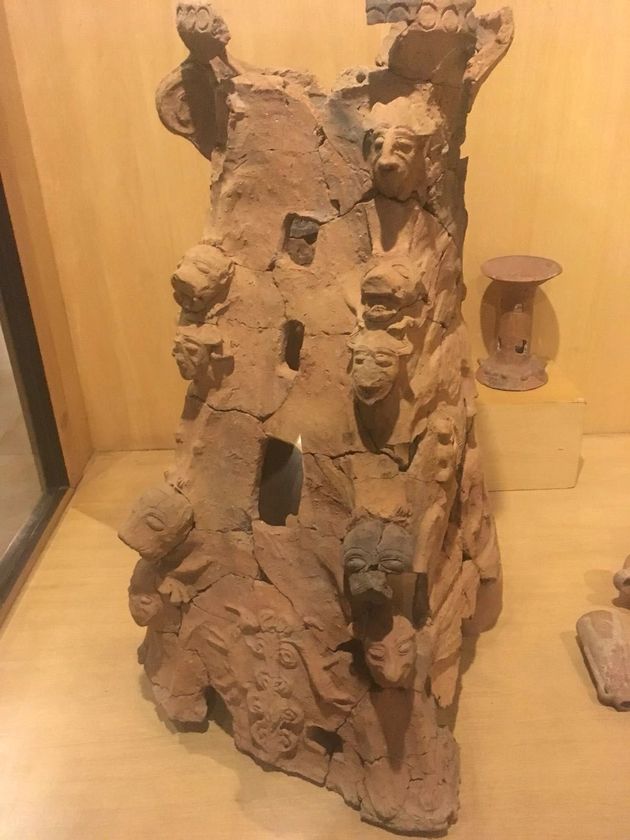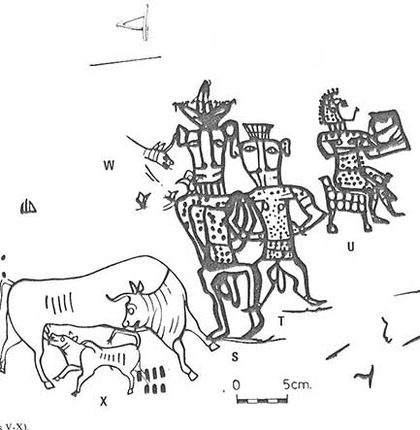One of the symbols that are used for Asherah is the “tree of life”, this may also be a reason why the woods provided a natural setting for those who sought her help.
 Asherah Altar, Istanbul Archaeology Museum. / Marc Madrigal
Asherah Altar, Istanbul Archaeology Museum. / Marc Madrigal
In a previous article, I briefly introduced Canaanite mythology and spoke chiefly about Baal. In this second article of the mini-series, we will explore the goddess Asherah.
Asherah was married to El, the chief god of the Canaanite pantheon. Asherah had numerous children from El. Among them were: Yamm, the god of the seas and rivers; Mot, the god of death and the underworld; and Anat; a goddess known as a warrior maiden.
Baal, the storm god, was also the son of Asherah, but according to the Ugaritic tablets he is said to be fathered by Dagon, a god of the earth and grain, primarily worshipped by the Philistines.
While the worship of Baal concentrated on “high places,” the worship of Asherah seems to have been focused primarily, though not exclusively, in groves and forests. As a mother goddess, these would have been the ideal settings for her worship.
Ugaritic and other Canaanite materials associate Asherah with several symbols like lions (indicating power), serpents (representing healing), and sacred trees (perhaps pointing to life and longevity).
AHERAH AND THE TREE OF LIFE
One of the symbols that are used for Asherah is the “tree of life”, this may also be a reason why the woods provided a natural setting for those who sought her help. Asherah would undoubtedly be visited by barren women or women who wished for a healthy pregnancy.
Given the fact that infant mortality rates were higher in antiquity then it is today, it is not surprising to understand why she was so revered. The tree of life imagery might also suggest healing properties, so perhaps she was also visited by women who had gynecological diseases.
Several altars used for Asherah worship have been unearthed. One of them is to be found in the Istanbul Archaeological Museum. The altar has traces of smoke in its inner section, pointing to the fact that it was most likely used to burn incense. In the altar, one notices the tree of life imagery also.
The fact that the tree of life is associated with Asherah leads some scholars to believe that the usage of this imagery in Scripture might be polemical in nature. In other words, a way for the Biblical authors to make the point that Yahweh and not Asherah is the source of life and the true healer of man.
The Hebrew word Ashe·rah (pl., ashe·rim) appears 40 times in the Bible is thought to refer to both a sacred wooden pole representing the goddess Asherah (Judges 6:25, 26) and the goddess Asherah herself (see 2. Kings 13:6).
It is not always possible to determine whether a particular scripture is to be understood as referring to the idolatrous object, or to the goddess unless we have some contextual help. Perhaps the pole is just another symbolism for the tree of life.
Regardless, the Israelites were commanded to cut them down and to burn them (Exodus 34:13; De 12:3). The Hebrews were instructed very clearly: “You shall not plant any tree as an Asherah beside the altar of the Lord your God that you shall make.” (Deuteronomy 16:21, ESV)
THE WORSHIP OF ASHERAH IN ISRAEL
Jezebel, Ahab’s Phoenician wife, entertained 450 prophets of Baal and 400 prophets of Asherah (1. Kings 18:19). Unfortunately, the worship of Asherah came to be practiced in the very temple of Yahweh.
 Kuntillet Ajrud Inscription. / Wikimedia Commons.
Kuntillet Ajrud Inscription. / Wikimedia Commons.King Manasseh went as far as to place a carved image of Asherah there (2. Kings 21:7). Things seemed to turn for the better with King Josiah and his reforms. He “broke down the houses of the male cult prostitutes who were in the house of the Lord, where the women wove hangings for the Asherah”. (2. Kings Ki 23:4-7, ESV).
Unfortunately, Josiah’s reforms were short lived. In Jeremiah, we learn that the people persisted in their ways. Many scholars believe that Jeremiah’s mention of the "Queen of Heaven” is none other than Asherah herself.
As the wife of El and the mother of Baal and the elohim, this would make sense. I find this suggestion very reasonable. In Jeremiah we learn that the people offered baked bread and drink offerings in exchange for Asherah’s influence in their lives:
“As for you, do not pray for this people, or lift up a cry or prayer for them, and do not intercede with me, for I will not hear you. Do you not see what they are doing in the cities of Judah and in the streets of Jerusalem? The children gather wood, the fathers kindle fire, and the women knead dough, to make cakes for the queen of heaven. And they pour out drink offerings to other gods, to provoke me to anger. Is it I whom they provoke? declares the Lord. Is it not themselves, to their own shame? Therefore thus says the Lord God: Behold, my anger and my wrath will be poured out on this place, upon man and beast, upon the trees of the field and the fruit of the ground; it will burn and not be quenched.” (Jeremiah 7:16-20, ESV)
KUNTILLET AJRUD
One of the fascinating archaeological traces of this period of syncretism is to be found in Kuntillet Ajrud. Kuntillet Arjud is located on a hill that lies 50 kilometers south of Kadesh Barnea.
In the site, which was excavated in 1975 by Tel Aviv University archaeologist Ze'ev Mashel. Several pottery shards were found with inscriptions and paintings. The paintings depicted several animals, stylised trees, and human figures.
But what was even more fascinating were the inscriptions. The inscriptions included statements like “Yahweh of Samaria and his Asherah”. Scholars dispute as to what this means. Some interpret the “Asherah” here as a cultic object, like the Asherah poles, while others interpret this word as a reference to the goddess.
In this latter case, this would mean that the Israelites came to worship Asherah as a consort of Yahweh. A surprising aspect of this find is its location. Why would the mention of Israel be found so far south in a territory traditionally pertaining to the land of Judah?
Meshel states that: “The bible says that war broke out between Amatzia, king of Judah, and Yoash, king of Israel” (see 2 Chronicles 25:17-28). Its possible that this site was built during the brief period of time that Judah became a Vassal to the State of Israel. This would then explain the existence of these writings.
The widespread worship of Asherah by pre-exilic Hebrews suggests that for many people, relying solely on Yahweh for comfort, sustenance and security was not enough. It’s not that they ever ceased worshipping Yahweh, rather they added upon the worship of Yahweh.
Perhaps Asherah offered the people that sense of comfort and security that comes with a motherly figure. In any case, this worship of the queen of Heaven was strongly condemned by Jeremiah, and it would be through the experience of the exile that the people would learn to rely on Yahweh instead of the numerous Canaanite gods.
Marc Madrigal is a Board member in the Istanbul Protestant Church Foundation in Turkey.
BIBLIOGRAPHY
Ackerman, Susan. Asherah/Asherim: Bible. Jewish Women’s Archives. Encyclopedia. https://jwa.org/encyclopedia/a
Hasson, Nir. A Strange Drawing Found in Sinai Could Undermine Our Entire Idea of Judaism. Haaretz. April 4, 2018. https://www.haaretz.com/israel
Mythologies of the Ancient World. SAMUEL NOAH KRAMER (ed.). Chicago: Quadrangle Books, Inc., 1961.https://archive.org/strea
White, Ellen. Asherah and the Asherim: Goddess or Cult Symbol? https://www.biblicalarchaeolog

Las opiniones vertidas por nuestros colaboradores se realizan a nivel personal, pudiendo coincidir o no con la postura de la dirección de Protestante Digital.
Si quieres comentar o